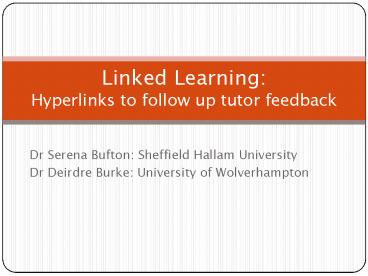Dr Serena Bufton: Sheffield Hallam University - PowerPoint PPT Presentation
1 / 24
Title:
Dr Serena Bufton: Sheffield Hallam University
Description:
Lack of guidance for students on what to do with feedback (Weaver 2006) No guidance on how to address issues in tutor ... Activity 1. Unpacking tutor feedback ... – PowerPoint PPT presentation
Number of Views:139
Avg rating:3.0/5.0
Title: Dr Serena Bufton: Sheffield Hallam University
1
Linked Learning Hyperlinks to follow up tutor
feedback
- Dr Serena Bufton Sheffield Hallam University
- Dr Deirdre Burke University of Wolverhampton
2
Overview
- Student use of tutor feedback
- Activity 1. Acting on feedback
- Activity 2. Feedback Tutorial Template
- Research
- Sheffield Hallam
- Wolverhampton
- Activity 3. Feasibility
3
Strategy
- Lack of guidance for students on what to do with
feedback (Weaver 2006) - No guidance on how to address issues in tutor
feedback (Burke 2007) - Lack of clarity on what appropriate work would
look like (Sommers 1982).
4
Gap in perceptions of feedback
Maclellan, E Assessment for Learning the
differing perceptions of tutors and students in
Assessment and Evaluation in Higher Education,
Vol.26, No.4, 2001. pp. 307- 318.
5
Student use of tutor feedback
- Students do not read feedback
- If they read feedback is often misunderstood
- Even when read and understood is rarely acted
upon. - (Falichikov 1995)
- Challenge
- - to get students to read, understand and act on
feedback.
6
Strategy
- Lack of guidance for students on what to do with
feedback (Weaver 2006) - No guidance on how to address issues in tutor
feedback (Burke 2007) - Lack of clarity on what appropriate work would
look like (Sommers 1982).
7
Gap in perceptions of feedback
Maclellan, E Assessment for Learning the
differing perceptions of tutors and students in
Assessment and Evaluation in Higher Education,
Vol.26, No.4, 2001. pp. 307- 318.
8
Centre for Excellence in Teaching and Learning
Critical Interventions for Enhanced Learning
(CIEL)
- The ASK approach
- ATTITUDE change- to help students rethink their
belief in assignment/learning closure - STRATEGIES (recognition of variety of learning
styles and needs as a starting point) electronic
links/ academic study skills feedback tutorials - KNOWLEDGE (cognitive and practical)
- Understanding the need to act on feedback.
- Knowing how to act on feedback.
9
How do I find out what more analysis means?
10
Activity 1. Unpacking tutor feedback
- Please get into pairs to explore the feedback on
the introduction to the essay. - One person act as the student requesting support
- One person act as a Skills Tutor (see next
slide) - Ten minutes to draw out issues from the feedback
and suggest ways for the student to act on advice.
11
Study Skills Advisor
- Role
- To deal with a range a issues students wanted
help with - Help unpick tutor feedback
- Suggest further resources or support staff
- Be a critical friend
12
(No Transcript)
13
Three levels
14
(No Transcript)
15
Underlying pedagogy
- Students need to take ownership of their work, to
accept and understand tutor comments to align
their work against learning outcomes - Formative feedback encourages students to develop
their work to achieve academic literacy
writing in the way required by their discipline - Role of exemplars to help students see what is
required by their subject, also seeing other work
helps students to be objective about their own
work.
16
Activity 2. Feedback template
- In your pairs reverse roles
- One person to act as the student
- One person to act as Skills Tutor and complete
the Feedback tutorial form during the tutorial.
17
Our student feedback on Electronic Links
I start with one link and work across the 3 areas
recommended.
- Prioritising
- Learning Styles met
- Convenience
- Level/Nature of link
Im much more likely to use this link than
looking at a study skills book
18
Sheffield Hallam University Research findings
- 1. Formative Assessment in Science (FAST)
- 2. The Assessment for Learning Initiative
(TALI) - 3. Technology, Feedback, Action
19
University of Wolverhampton
- Key issues
- Convenience
- 2. Prioritising
- 3. Learning Styles
- 4. Level/Nature of link
20
Student Feedback following session with Study
Skills Advisors
21
Over to you
- Please use the post-it notes to offer your
perspectives - Green aspects you think will work
- Blue suggestions for improvement
- Red problems
22
(No Transcript)
23
Thank you
- Thank you for your participation in this session,
if you would like more information or to be
involved in the research, please consult the
linked webfolio (http//pebblepad.wlv.ac.uk/webfol
io.aspx?webfolioid1112466) - or contact
- Deirdre.burke_at_wlv.ac.uk
24
References
- Burke, D. (2007) Getting the most out of
feedback in Nutt, D. Tidd, J. (Eds.) 1st
European First Year Experience Conference April
2006, pp. 36- 49, Teesside, University of
Teesside. - Falchikov, N. Improving Feedback To and From
Students, in Knight, P. (Ed.) (1995). Assessment
for Learning in Higher Education, London Kogan
Page, pp. 157- 166. - Lea, M.R. Street, B. (1998) Student Writing in
Higher Education an academic literacies
approach, Studies in Higher Education, 23 (2),
157-172. - MacLellan, E. (2001) Assessment for Learning the
differing perceptions of tutors and students,
Assessment and Evaluation in Higher Education
26(4), 307- 318. - Race, P. (2001) Using feedback to help students
to learn York Higher Education Academy. - Sommers, N. Responding to Student Writing
College Composition and Communication, Vol. 33,
No. 2., 1982, 148 156. - Weaver, M.R. (2006) Do Students value feedback?
Student perceptions of tutors written response,
Assessment and Evaluation in Higher Education,
31(3), 379-394.

